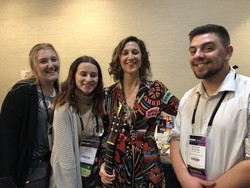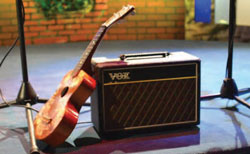Three Monmouth students had the opportunity to represent the university at the annual Association of Performing Arts Professionals (APAP) Conference in New York City from Jan. 9-14.
APAP is the largest international organization of performing arts professionals in the world. Agents, managers, presenters, bookers, venue operators, and talent of all kinds gather in the Midtown Hilton for almost a week of professional development sessions and keynote speakers. The Expo Hall is also opened with hundreds of agency booths of booking literature.
This year’s conference theme was Risk and Resilience, and many of the professional development sessions discussed themes of self-promotion, perseverance, curiosity, and exploration of new avenues in the industry.
The closing keynote speaker was multi-platinum singer/songwriter Ben Folds. He could not be reached for comment.
Jenna Hawryluk and Rachel Disipio, senior music industry students, and myself, were sent to the conference courtesy of the Monmouth University Center for the Arts to see a side of the entertainment industry many do not. To attend, however, there was a catch: We would have to register for the conference as student volunteers. We would be working it.
Vaune Peck, the Director for the Center for the Arts, said, “It’s so rewarding for me to take students to this conference and watch them revel in the experience. It’s such a wonderful opportunity for music industry majors and others interested in the industry.”
Other student volunteers were high school and college aged from across the globe; California, China, Nicaragua. The volunteers were tasked with running the registration booths, monitoring the exposition hall, distributing surveys, scanning attendees into various portions of the conference, and running around to complete tasks.
Mario Garcia Durham, CEO and President of APAP, said, “Many people help make our conference a success, but our volunteers are perhaps the most significant. With a wide array of duties to provide for over 3,600 attendees, crucial tasks would go incomplete without your hard work. From the complexity of registration to simply helping someone find their way, you provided our attendees with a world-class experience.”
Another pivotal aspect of the APAP conference are the showcases. A showcase is a 15 minute to hour long demonstration of a performer’s show. The intention is to give agents, venue executives, and arts presenters a taste of what their show would look like, and hopefully get booked. These showcases begin as early as 9 a.m. and usually don’t end until 2 a.m. Many are held within the hosting hotel, but they are also spread out at hundreds of venues across NYC. At check-in, the program details about 600 pages of showcases over the week’s time.
Celebrities such as members of the Zak Brown Band, the King of the Twist Chubby Checker, and many more can also be found exploring the conference and/or performing. Dance troupes, magicians, thespians, prodigies, comedians, poets, and a list of other performers converge and wander.
Another big reason these industry professionals attend APAP is the Networking Lounge, where they can connect with others and talk business.
Disipo said, “The conference provided several opportunities for us to meet industry professionals and other students, allowing us to expand our networks in the entertainment field.”
Hawryluk said, “We were able to experience how booking agents and other performing arts industry professionals find the best talent for possible shows in the future. We were able to see a diverse amount of performers that could potentially come to our University in the upcoming years.”
Hawryluk continued, “It was an experience I’ve never had before. And it was so much fun to see the talent I wouldn’t have been able to see if I didn’t go.”
A conference of this size is not without minor setbacks, however. A registrant’s badge costs about $900 to attend the conference. There were a few scammers who attended previous years and made photo copies of that year’s badge and tried to sell it to desperate shut-outs. Others would say they “forgot” their badge and try to enter restricted areas. The volunteers and staff caught multiple people engaging in unethical practices, and referred them to the authorities.
PHOTO COURTESY of Ray Romanski



